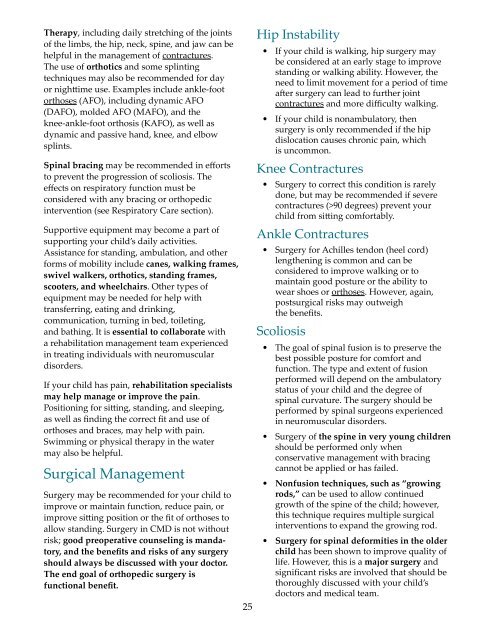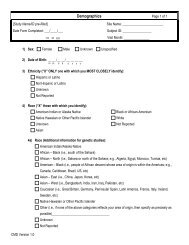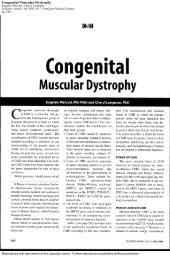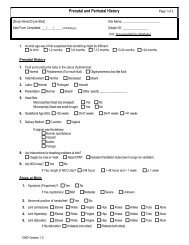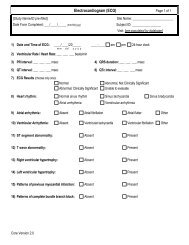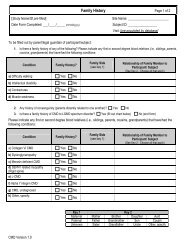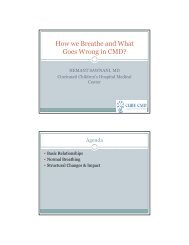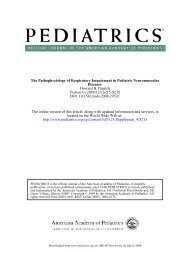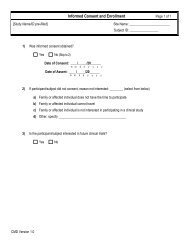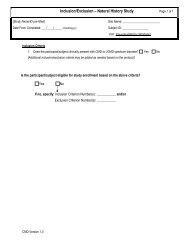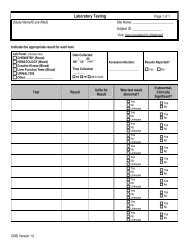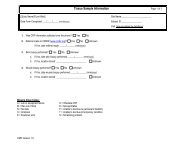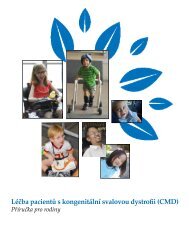The Management of Congenital Muscular Dystrophy ... - Cure CMD
The Management of Congenital Muscular Dystrophy ... - Cure CMD
The Management of Congenital Muscular Dystrophy ... - Cure CMD
You also want an ePaper? Increase the reach of your titles
YUMPU automatically turns print PDFs into web optimized ePapers that Google loves.
<strong>The</strong>rapy, including daily stretching <strong>of</strong> the joints<strong>of</strong> the limbs, the hip, neck, spine, and jaw can behelpful in the management <strong>of</strong> contractures.<strong>The</strong> use <strong>of</strong> orthotics and some splintingtechniques may also be recommended for dayor nighttime use. Examples include ankle-footorthoses (AFO), including dynamic AFO(DAFO), molded AFO (MAFO), and theknee-ankle-foot orthosis (KAFO), as well asdynamic and passive hand, knee, and elbowsplints.Spinal bracing may be recommended in effortsto prevent the progression <strong>of</strong> scoliosis. <strong>The</strong>effects on respiratory function must beconsidered with any bracing or orthopedicintervention (see Respiratory Care section).Supportive equipment may become a part <strong>of</strong>supporting your child’s daily activities.Assistance for standing, ambulation, and otherforms <strong>of</strong> mobility include canes, walking frames,swivel walkers, orthotics, standing frames,scooters, and wheelchairs. Other types <strong>of</strong>equipment may be needed for help withtransferring, eating and drinking,communication, turning in bed, toileting,and bathing. It is essential to collaborate witha rehabilitation management team experiencedin treating individuals with neuromusculardisorders.If your child has pain, rehabilitation specialistsmay help manage or improve the pain.Positioning for sitting, standing, and sleeping,as well as finding the correct fit and use <strong>of</strong>orthoses and braces, may help with pain.Swimming or physical therapy in the watermay also be helpful.Surgical <strong>Management</strong>Surgery may be recommended for your child toimprove or maintain function, reduce pain, orimprove sitting position or the fit <strong>of</strong> orthoses toallow standing. Surgery in <strong>CMD</strong> is not withoutrisk; good preoperative counseling is mandatory,and the benefits and risks <strong>of</strong> any surgeryshould always be discussed with your doctor.<strong>The</strong> end goal <strong>of</strong> orthopedic surgery isfunctional benefit.25Hip Instability• If your child is walking, hip surgery maybe considered at an early stage to improvestanding or walking ability. However, theneed to limit movement for a period <strong>of</strong> timeafter surgery can lead to further jointcontractures and more difficulty walking.• If your child is nonambulatory, thensurgery is only recommended if the hipdislocation causes chronic pain, whichis uncommon.Knee Contractures• Surgery to correct this condition is rarelydone, but may be recommended if severecontractures (>90 degrees) prevent yourchild from sitting comfortably.Ankle Contractures• Surgery for Achilles tendon (heel cord)lengthening is common and can beconsidered to improve walking or tomaintain good posture or the ability towear shoes or orthoses. However, again,postsurgical risks may outweighthe benefits.Scoliosis• <strong>The</strong> goal <strong>of</strong> spinal fusion is to preserve thebest possible posture for comfort andfunction. <strong>The</strong> type and extent <strong>of</strong> fusionperformed will depend on the ambulatorystatus <strong>of</strong> your child and the degree <strong>of</strong>spinal curvature. <strong>The</strong> surgery should beperformed by spinal surgeons experiencedin neuromuscular disorders.• Surgery <strong>of</strong> the spine in very young childrenshould be performed only whenconservative management with bracingcannot be applied or has failed.• Nonfusion techniques, such as “growingrods,” can be used to allow continuedgrowth <strong>of</strong> the spine <strong>of</strong> the child; however,this technique requires multiple surgicalinterventions to expand the growing rod.• Surgery for spinal deformities in the olderchild has been shown to improve quality <strong>of</strong>life. However, this is a major surgery andsignificant risks are involved that should bethoroughly discussed with your child’sdoctors and medical team.


